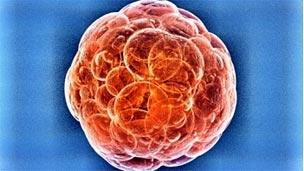Q&A: Stem cells
- Published

Embryonic stem cells have the potential to create virtually any human cell or tissue
What are stem cells?
Most adult cells in the body have a particular purpose which cannot be changed.
For instance, a liver cell is developed to perform specific functions, and cannot be transformed to suddenly take on the role of a heart cell.
Stem cells are different. They are still at an early stage of development, and retain the potential to turn into many different types of cell.
Why are they so useful?
When a stem cell divides, each new cell has the potential to either remain a stem cell or become another type of cell with a more specialised function.
Scientists believe it should be possible to harness this ability to turn stem cells into a super "repair kit" for the body.
Theoretically, it should be possible to use stem cells to generate healthy tissue to replace that either damaged by trauma, or compromised by disease.
Among the conditions which scientists believe may eventually be treated by stem cell therapy are Parkinson's disease, Alzheimer's disease, heart disease, stroke, arthritis, diabetes, burns and spinal cord damage. Early trials are underway for treating forms of blindness.
Stem cells may also provide a useful way to test the effects of experimental drugs.
It is also hoped that studying stem cells will provide vital clues about how the tissues of the body develop, and how disease takes hold.
Are there different types of stem cell?
Yes. Scientists believe the most useful stem cells come from the tissue of embyros.
This is because they are pluripotent - they have the ability to become virtually any type of cell within the body.
Stem cells are also found within adult organs. They have not taken on a final role, and have the potential to become any of the major specialised cell types within that organ.
Their role is to maintain the organ in a healthy state by repairing any damage it suffers.
Another form of stem cell - induced pluripotent stem cells - are made by coaxing skin cells to shed their specialist role and become a stem cell.
This was developed in 2006 and could offer the benefits of embryonic stem cells without the ethical problems, but there may be a cancer risk as a result of the reprogramming.
In 2014, it was announced that blood cells could be converted into stem cells with a very simple method - dipping them in acid for half an hour.
It promised to offer a cheap, fast and safe source of stem cells, but the work was later discredited amid concerns that some of the results had been discredited.
Is the use of stem cells controversial?
Very. Campaigners are vehemently opposed to the use of embryonic stem cells.
These cells are typically taken from lab-created embryos that are just four or five days old, and are little more than a microscopic ball of cells.
However, opponents argue that all embryos, whether created in the lab or not, have the potential to go on to become a fully fledged human, and as such it is morally wrong to experiment on them.
They strongly advocate the use of stem cells from adult tissue.
Are there safety concerns?
Yes. Some researchers fear that it is possible that stem cell therapy could unwittingly pass viruses and other disease causing agents to people who receive cell transplants.
Some research has also raised the possibility that stem cells may turn cancerous.
Work also still needs to be done to refine the new technique. Similar results were achieved by two teams using a different combination of gene-controlling proteins.
In both cases the success rate in producing new stem cells was also low.